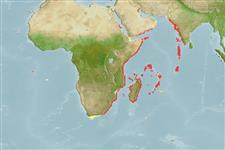Environment: milieu / climate zone / depth range / distribution range
Ekologi
laut berasosiasi dengan karang; nir-ruaya; kisaran kedalaman 6 - 40 m (Ref. 9710). Tropical
Western Indian Ocean: Somalia to East London, South Africa. Also around oceanic islands. Common off East Africa (Ref. 9710).
Size / Weight / umur
Maturity: Lm ? range ? - ? cm
Max length : 8.0 cm TL jantan/; (Ref. 5953)
deskripsi pendek
Kunci identifiaksi (pengenalan) | Morfologi | Morfometrik
Head, upper sides, dorsal, and caudal fins golden yellow; lower two-thirds of the body and the anal fin black with numerous close-set purple spots.
Inhabits areas with coral rubble and frequently occurs in small groups of up to about 10 individuals. Feeds on small invertebrates and algae (Ref. 5503). Spawns at sunset; male stimulating the emission of eggs with biting motions on female's abdomen; eggs released and abandoned in open water without any particular parental care (Ref. 5503). Popular aquarium fish in Natal. Occasionally exported from Kenya.
Life cycle and mating behavior
Maturities | Reproduksi, perkembang biakan | Spawnings | Egg(s) | Fecundities | Larva
Bi-directional sex change has been confirmed for this species (Ref. 103751).
Allen, G.R., 1985. Butterfly and angelfishes of the world. Vol. 2. 3rd edit. in English. Mergus Publishers, Melle, Germany. (Ref. 4858)
Status IUCN Red List (Ref. 130435)
ancaman kepada manusia
Harmless
penggunaan manusia
Perikanan: tidak ada kepentingan; Akuarium: Komersial
Alat, peralatan
laporan khas
muat turun XML
Sumber internet
Estimates based on models
Preferred temperature (Ref.
123201): 24.6 - 27.8, mean 26.8 °C (based on 84 cells).
Phylogenetic diversity index (Ref.
82804): PD
50 = 0.5000 [Uniqueness, from 0.5 = low to 2.0 = high].
Bayesian length-weight: a=0.03090 (0.01359 - 0.07026), b=2.89 (2.70 - 3.08), in cm total length, based on LWR estimates for this (Sub)family-body shape (Ref.
93245).
Trophic level (Ref.
69278): 2.9 ±0.32 se; based on food items.
Daya lenting (Ref.
120179): Tinggi, Waktu penggandaan populasi minimum kurang dari 15 bulan (Preliminary K or Fecundity.).
Fishing Vulnerability (Ref.
59153): Low vulnerability (10 of 100).
Nutrients (Ref.
124155): Calcium = 125 [61, 193] mg/100g; Iron = 0.772 [0.462, 1.296] mg/100g; Protein = 18.1 [16.9, 19.3] %; Omega3 = 0.126 [0.074, 0.209] g/100g; Selenium = 23.6 [12.5, 44.2] μg/100g; VitaminA = 114 [32, 393] μg/100g; Zinc = 1.86 [1.26, 2.70] mg/100g (wet weight);
